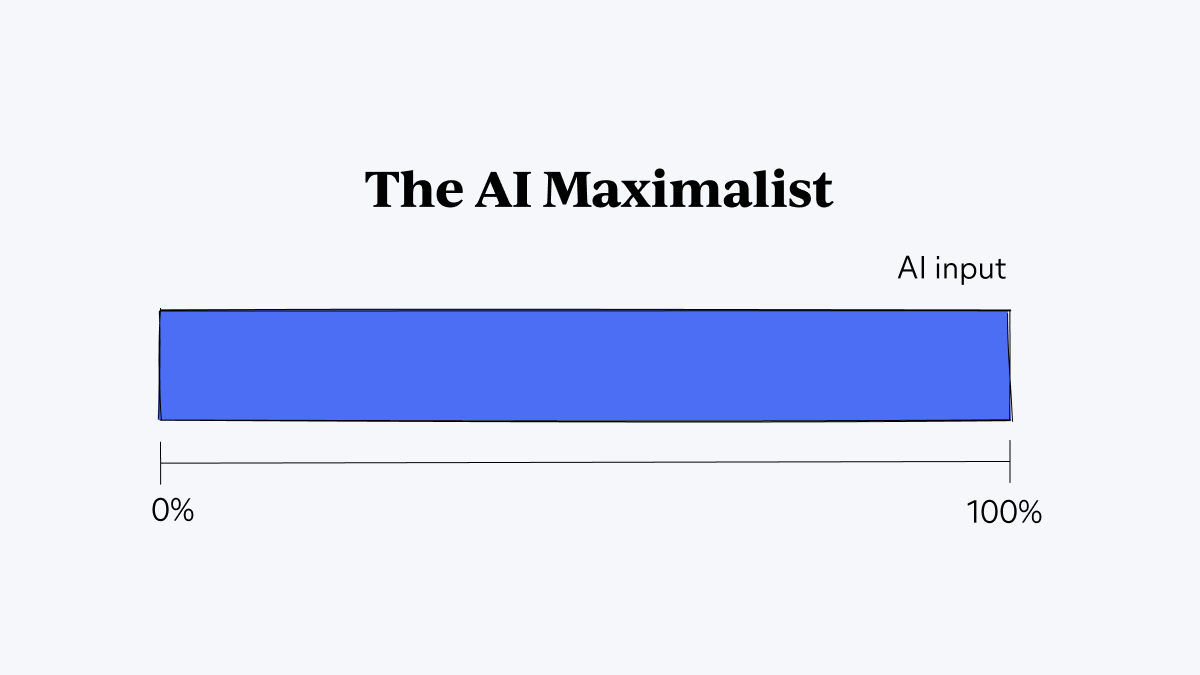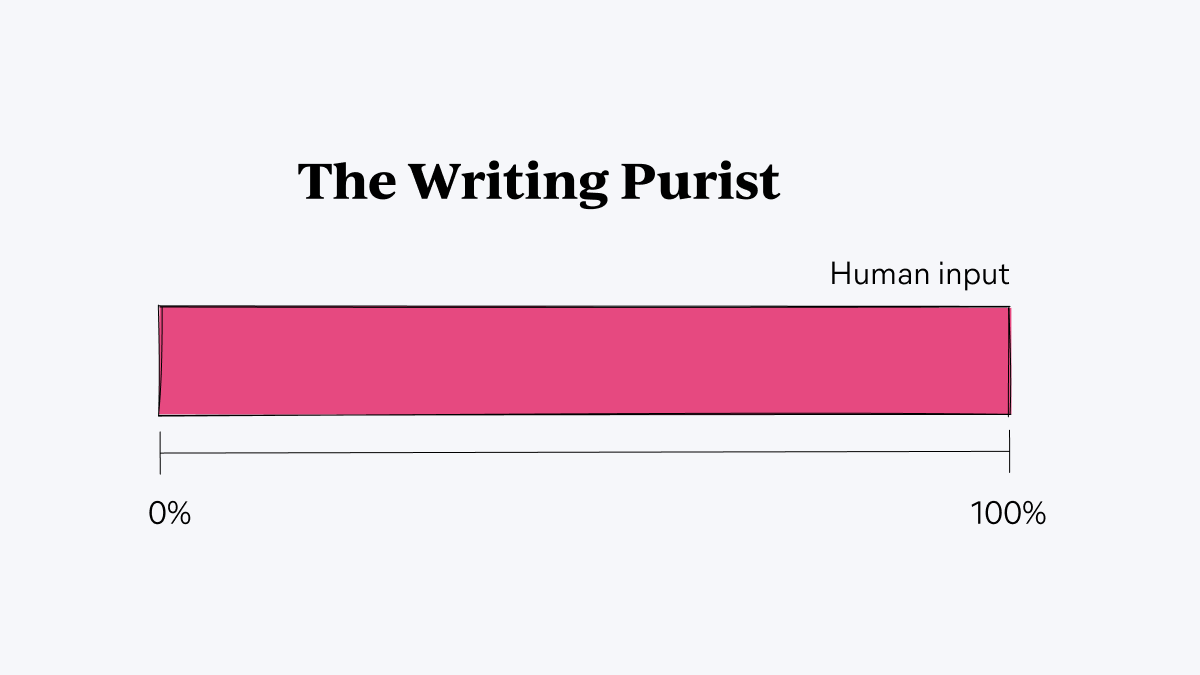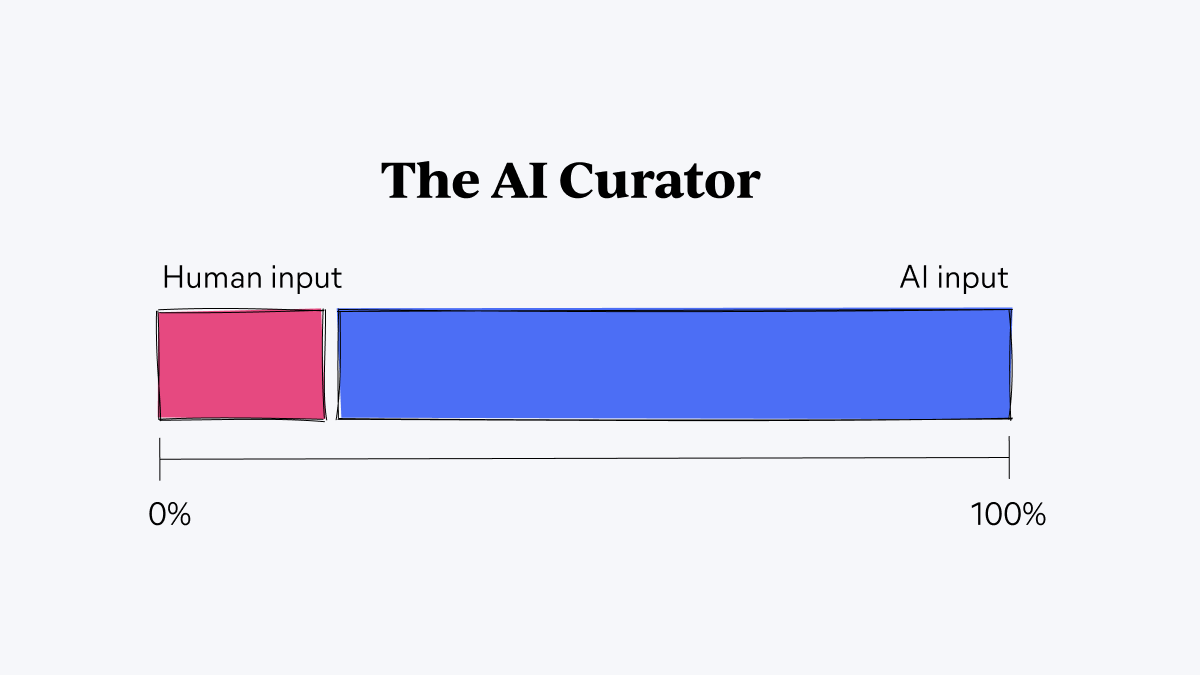AI is a force multiplier for great writers.
It took us a long time to say that. Two years of experimenting with a host of generative writing tools — GPT-3, Copy.ai, Writer, Jasper, and ChatGPT. But our decision is: it’s an advantage. And because we think it’s an advantage, we’re incorporating it — in thoughtful, measured ways — into the work we do for ourselves and for customers also interested in experimenting.
We’ve found that we can create great content — content that gets results — with a blend of human and machine. And we’ve dubbed this blend: the Content Cyborg.
Here’s why and how you should integrate AI writing tools into your content marketing.
The Content Cyborg
There are two inputs you can have in your content — human and AI. The question is: how much of either should you use?
The AI Maximalist
There are people with what we call the “AI maximalist” mindset, who use generative writing tools to create all of their writing. And we’ve learned from our experimentation that generative large language models do have obvious advantages over squishy human brains:
They are better read.
They can generate text faster.
They don’t suffer from mental blocks or creative ruts.
It’s certainly possible to write articles entirely with these tools using a one-shot content workflow and publish the output verbatim. But that is, in our opinion, a losing proposition.

Generative AI models have substantial weaknesses:
They create fiction and present it with all the certainty of sure fact.
They struggle to understand context — how any particular thought or subject fits into the bigger picture.
Left unchecked, they ramble and meander.
Perhaps most important: they can’t go out into the world, experience, conduct research, or form opinions (although they can pretend that they did).
Even if these language models progressed to a point where these problems didn’t exist, there would be no competitive advantage to using their output verbatim: everyone with access to the same freemium SaaS product could generate content of comparable quality (creating what we’ve dubbed “the search singularity”).
The Writing Purist
For every AI maximalist, though, there are probably many more “writing purists,” people intent on preserving the integrity of “human” writing. Every idea, outline, draft, and revision is fueled by black coffee and gray matter:

This is, in our opinion, also a losing proposition. Human writers will never be as fast, as prolific, or, in some ways, as creative as generative AI. To avoid using these tools in any capacity is like choosing to work with one hand tied behind your back. Even if you achieve great results, you’re still needlessly hindering yourself. Other people will not play by the same constraints.
The Creative Sparring Partner
But allowing AI into even a small, well-contained part of your writing process can unlock incredible results. Take the idea of using it as a “creative sparring” partner: enlist its help with idea generation and brainstorming titles and angles.

Here, you, the human, still maintain full control of the actual writing and words-on-the-page, but you’ve overcome the constraints of human creativity, like mental fatigue, bias toward existing ideas, and plain old writer’s block.
The AI Curator
Or take the idea of becoming an “AI curator”: use generative AI for first drafts or simple utilitarian content like knowledge base articles or basic listicles. Focus your human energy on the highest-leverage parts of the writing process — intros, outros, structure, examples — and allow AI to do the heavy lifting of connecting your structure together.

From our experiments, some types of writing can be vastly aided by generative AI. Others will be hindered. Which leads us to…
The Content Cyborg
The most productive blend of writer and AI. One that uses the relative strengths of one to offset the weaknesses of the other.
Humans can’t produce en masse. AI can. AI can’t support an argument. Humans can. Humans can’t read the entirety of Wikipedia. AI already has. AI might ramble, left unchecked, but humans… well, every Venn diagram has to overlap somewhere.
Where one fails, the other picks up the slack.
We call this approach the content cyborg: part human, part technology, with the precise “mixture” of the two determined on a case-by-case basis.

This approach is, at least in the ways it can be, a conversation between both parties.
How to Use AI in Content Marketing Effectively
Here’s what we’ve learned in our experimentation with this blend of generative AI and human, this content cyborg, and how you can make it work for you.
1. Be Selective in Its Application
You have to understand the limitations of AI models. Generative AI is extremely helpful for topics that:
…are well-represented in its dataset. GPT-3 is well-read but not perfectly read — there are plenty of topics conspicuously absent from its data. The simplest way to test: try and generate a few dozen paragraphs. Does it provide concrete detail, or does it write in hand-waving generalizations? Does it cover the topic in useful depth, or does it paraphrase and repeat itself?
…don’t require a complicated narrative. Most SEO content doesn’t usually need a complex narrative to be successful: it’s enough to present clear ideas and arguments in an organized way. GPT-3 can create a convincing first draft of this kind but often loses the plot when tasked with something requiring a strong end-to-end narrative.
We also know (from hard-earned experience) that there are certain types of content that generative AI struggles with, particularly topics that:
…reference particular brands or products. GPT-3 can write convincingly about “Ecommerce analytics” but less convincingly about “Shopify analytics”; it can tackle “lead nurturing” with aplomb but descends into falsity when tasked with “lead nurturing sequences in HubSpot.”
…have changed dramatically since 2019. GPT-3’s pre-2020 dataset has little to offer on the “Best Ecommerce Podcasts in 2023” (although, if ChatGPT is anything to go by, we’ll soon have the ability to pull live web results into the dataset).
…require a ton of concrete data. Any article that requires an abundance of concrete data usually results in outdated or outright fabricated statistics in AI’s draft.
Many of these problems will grow less severe as models develop, datasets expand, and tools add more prompting guardrails (as we’re already seeing with ChatGPT). But even now, there are large subsets of content marketing that generative AI can support, generating useful first drafts for skilled writers to chop, change, and improve (more on that below).
2. Review Everything, Trust Nothing
Here’s the biggest issue with generative AI: it lies. But potentially more damaging, it doesn’t tell you when it lies. GPT-3 is a false confidence machine.
Generative AI is designed to create fluid, human-like text, stitching disparate ideas and prompts together in ways that seem to make sense. But there are problems with this approach:
There is no fact-checking mechanism within GPT-3 (nor will there ever be — what company would have the resources or inclination to assess and vouch for billions of generated claims?).
It often draws on source data that is, itself, incorrect. After all, who polices the internet?
It’s designed to write at all costs. Even when there is limited data in the dataset, it will continue to pump out writing with unhindered enthusiasm.
The solution is simple: we need a human in the loop, a subject matter expert able to analyze the validity of the output (“that’s the right formula for calculating ROAS” ), to identify crucial ideas absent from the generated text (“we need to mention MMS here, not just SMS”), but also to stand behind the published information.
3. Inject “Information Gain”
Great articles are set apart from good by their ability to bring something new to a topic: original data, a useful opinion, a practical experience, or an explanatory framework. It is this “information gain” over competing search results that provides a reason for readers to remember and care about your brand.
By default, generative AI struggles to provide any information gain. It functions much like a copycat content machine: creating new writing based largely on the existing literature on a given topic. And while, yes, AI might suggest a truly novel, interesting angle — it does so by generating 50 other equally uninteresting and often nonsensical ideas.
The goal isn’t to write everything with AI — the goal is to get great results from our content.
It’s a human writer’s job to seed the generated content with information gain, to add real-life examples; customer stories; accurate, trusted, and relevant data; product mentions; CTAs. All the stuff that makes content worth it.
4. Front-Load Article Structure
Our job in the “content cyborg” workflow — perhaps our most important job — is to provide a functioning structure within which AI can elaborate. We can be inspired by AI, but for something as crucial as structure, we shouldn’t be led by it.
The performance of any content is determined more by its overall structure than the makeup of any particular phrase.
Content should be weighted evenly and presented in a logical order. Its topic should be explored comprehensively using concepts like MECE. The page needs to flow using bolds, italics, bullet points, pull quotes. All tasks AI can’t manage.
Hit the big red “generate” button and AI writing tools default to long run-on sentences and paragraphs. They pump out walls of text that are generally hideous for the reader to slog through, with no thought to the “bigger picture” structure of the writing.
5. “Just Write”
Then sometimes, it’s better to just write the old-fashioned way.
When playing with generative AI tools, it’s easy for your ambition to edge closer and closer toward using AI to write everything for you. But crucially, the goal isn’t to write everything with AI — the goal is to get great results from our content. If there are areas where AI lets us do that faster or more effectively, we should embrace it. If there are areas where it doesn’t, we should embrace writing the old-fashioned way.
This is particularly true when you recognize the 80/20 nature of writing. There are parts of any given article that are more important than others — 20% of the article generates 80% of its impact:
The introduction, summarizing key arguments and piquing the reader’s interest
The headers, ensuring that the article delivers the promise created by its title
The conclusion, summarizing and providing a logical next step
Give humans the greatest involvement over the highest-stakes parts of the article, those that can make or break the reader’s experience. Trust your intuition. If it feels like the generated text is missing something, add it in. If it feels like it would be faster to write instead of generate (and regenerate), go ahead and write.
The Force Multiplier
There’s a common criticism leveled at generative AI: “If it takes so much effort to get good results from it, why bother?”
In some instances, the effort of using generative AI really does outweigh the reward — we’d be better served by just putting pen to paper, as it were. But this is compensated for by other types of content that can be hugely aided by the same technology, shaving hours of relatively unskilled, laborious effort from the writing process and freeing it up for higher-leverage things.
There is no contradiction here: generative AI is a tool like any other. Useful in some instances, useless in others. But crucially, content marketers — like us — have a responsibility to explore, understand, and use any tool that may better serve our goal of growing businesses through writing. Generative AI has changed the game. It’s a force multiplier for great writers, and we intend to use it.
